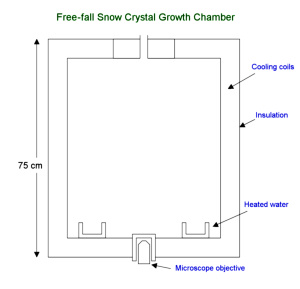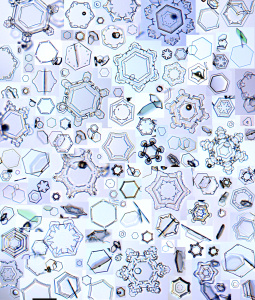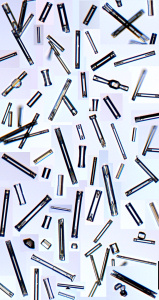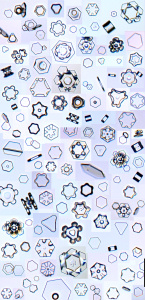|
| This is perhaps the simplest method I use to grow
snow crystals. It is quick and easy, but it only makes very tiny snow
crystals.On the other hand, it can make them by the millions. |
|

This
diagram shows the basic layout of one of my freezer snow crystal growth
chambers. The entire box is cooled to some desired temperature, say -15
C (5 F), and of course the freezer is insulated from the outside air.
Heated water inside the freezer puts water vapor into the air, making
the air supersaturated (the relative humidity is above 100%). I drop a
speck of dry ice into the chamber, and the cold nucleates thousands of
tiny ice crystals that begin to grow. The crystals are too tiny to see
in ambient light, but sparkles can be seen when I shine a bright
flashlight or laser pointer into the chamber. The sparkles are
reflections from the crystal facets.
The crystals fall as they
grow larger, and eventually they end up on the bottom of the chamber.
They fall after a minute or two, typically, and this fall time limits
how large the crystals can become.
I call these freezer
snowflakes, because you can grow them just fine in an ordinary
top-loading freezer. This method was first demonstrated by Vincent
Schaefer at the General Electric Research Laboratory in 1946. |
| 
This
image shows a collage of many freezer snow crystal photographs. These
crystals were all grown when the chamber temperature was -15 C (5 F) --
just right for making thin plates and stars. (See the morphology diagram.
) There is a small 50-micron scale bar at the bottom of the picture;
this is about the diameter of a human hair. These are small crystals!
These
crystals were grown with a high water temperature, so there was a lot
of humidity in the air. High humidity means more complex crystals, with
lots of structure. With lower water temperatures, the humidity is
lower, and then simple hexagonal plates appear. |
|  
Here
are more freezer crystals. The ones on the far left were grown with a
chamber temperature of -5 C (23 F), which is right for growing columns
and needles. The near left image shows crystals grown when the chamber
temperature was -2 C (28 F), where small plates grow. In both pictures,
the 50-micron scale bars are on the right side, near the bottom.
| | |
|
|
|
